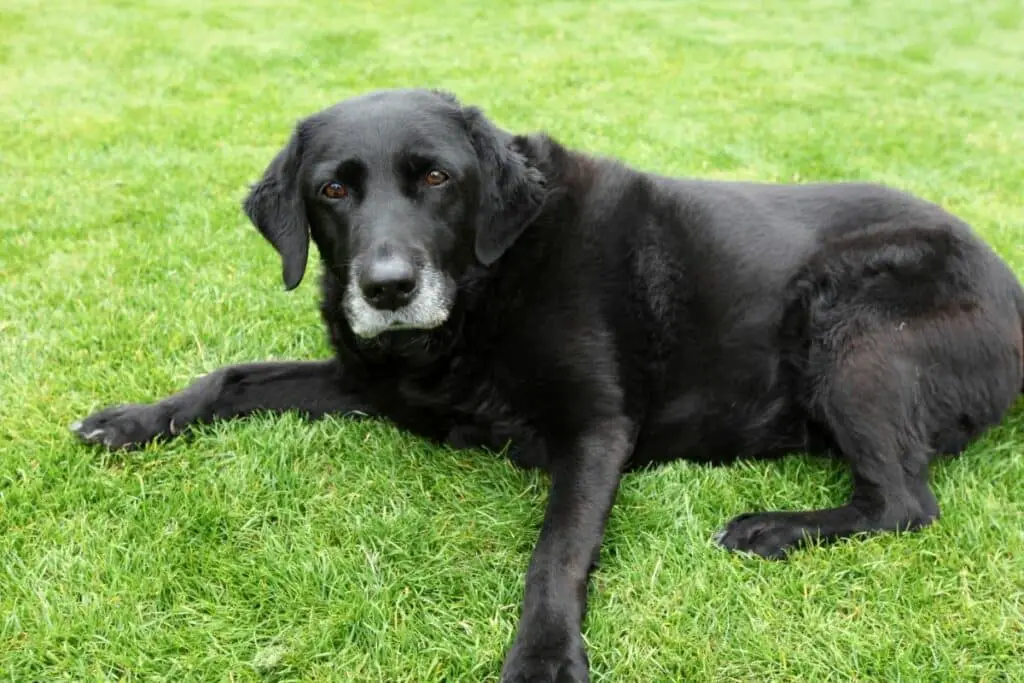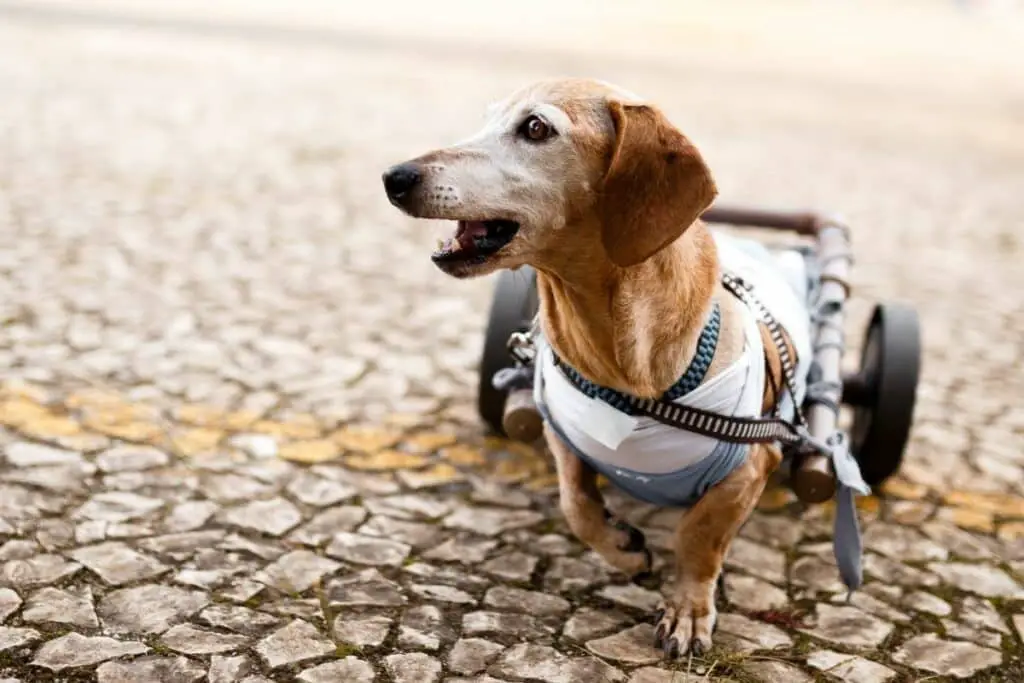Symptoms of hind leg weakness could be immediate or develop over time, based on the root cause. Keep an eye on your pet’s physical condition and behavior as this could indicate other signs of dog back leg weakness.
Dogs who suffer from hind leg weakness may show symptoms such as walking stiffly, favoring the affected limb, or weakness. Lack of coordination means your dog needs extra care.

Walking problems mean your dog may need help getting around. Their legs might be wobbly when they walk. They might have trouble standing up straight.
They may be tired because they’re carrying too much extra weight. They may also have difficulty urinating because they have weak back legs or hips.
So, let’s take a look at this issue in more detail!
What Causes Sudden Hind Leg Weakness in Dogs?
Weakness in the hind legs is often caused by injury or disease. A broken leg may cause weakness in the back legs. An infection such as arthritis or gout can also cause weakness in the hind legs.
Hip Dysplasia
Dogs who have hip dysplasia may be prone to falling over. Their legs may become stiff or weak. This condition can cause arthritis and other problems. These dogs should be treated by a veterinarian.
Genetics mainly cause hip dysplasia, however, other factors such as size and weight can also contribute to the condition.
Arthritis
Dogs can get arthritis, too. Your dog may be suffering from osteoarthritis. You should take him/her to the vet if he/she has trouble getting up the stairs or walking.
Diabetes
Diabetes affects dogs’ legs, which could cause them to be weaker than usual. This can lead to problems such as being thirsty and hungry. A blood test can help determine if your dog has diabetes.
Canine Degenerative Myelopathy
Degenerative myelopathy is a disease that affects dogs’ spinal cords. Dogs may experience quivering hind legs, or legs that come together while they stand. Their feet may be positioned at unusual angles.
This spinal condition occurs in many breeds, including Boxers, German Shepherds, Cardigans, and Rhodesian Ridgebacks.
Limited Mobility
Temporary disability occurs when an injury or illness prevents you from doing something for a short period of time. Your dog may be temporarily disabled if he needs to rest after undergoing TPLO surgery.
Fibrocartilaginous Embolism
Fibrocartilaginous Embolism (FCE), also known as canine spinal cord syndrome or vertebral artery entrapment syndrome, is a condition in dogs caused by a small piece of cartilaginous material blocking the flow of blood to the spinal cord.
This blockage causes an accumulation of fluid around the spinal cord and may cause paralysis of the affected limb(s). Symptoms include weakness or paralysis of the hind limbs, difficulty walking, drooling, and/or vomiting.
Treatment includes surgery to remove the obstruction and medication to reduce inflammation. Large and giant dogs are prone to this kind of blood clotting disorder. German shepherds and Irish wolfhounds are two breeds often affected by this condition.

Give Your Pet Bone Joint Supplements
Joint supplements help dogs get better nutrition. They also reduce the amount of inflammation in your dog’s body.
Your dog needs bone and joint supplements to stay healthy. These supplements include glucosamine, chondroitin, collagen, and fish oil.
Keep Your Dog at a Healthy Weight
Your dog may need extra exercise if he/she is overweight. Bones may become weak and other health problems may occur.
Include More Protein in Your Dog’s Diet
Bones need protein to be strong and healthy. Your dog needs to eat more protein than other dogs to get enough calcium.
Pumpkin seeds, potatoes, and oatmeal are great sources of protein. Chicken, beef, and tuna are also good choices for your dog.
Get Your Furry Friend Moving
Walking is a great way to help strengthen your dog’s back leg muscles. Keep it slow and short.
Don’t let your dog run too far because it might get injured. Stretch your dog’s hind legs for more muscle strength. Have your dog lay down and give their legs some exercise.
Give Your Dog Vitamins and Minerals
Dogs need vitamin D and magnesium to stay strong. These nutrients help them absorb calcium, which keeps their bones healthy.
Collagen also keeps bones strong and healthy. Free radicals cause cell damage. Vitamin E protects dogs’ cells from free radical damage.
Degenerative Myelopathy in Dogs
Degenerative myelitis is caused by inflammation of the nerve roots. It causes weakness in the legs. It is similar to ALS in humans.
Both diseases affect the spinal cord. Osteoarthritis in humans is caused by wear and tear of the cartilage in joints. This causes pain and stiffness.
Later stages of the disease cause weakness and ataxia. Spinal injuries, spinal tumors, spinal stenosis, fibrocartilaginous embolisms, myasthenia gravis, and discospondylitis are other conditions associated with osteoarthritis.
What Breeds are Most Commonly Affected?
Dogs who develop DM are more likely to be male than female. Genetic mutations are the main cause of DM. Breeds that are most susceptible include German Shepherds, Siberian Huskies, Collies, Bernese Mountain Dogs, and Pembroke Welsh corgis.
All dog breeds come with predispositions to certain health conditions. This is because of the way that these dog breeds have been bred throughout the years.
Hip dysplasia is actually a very common health condition for many dog breeds. Especially as these dogs get earlier.
As you can see from the list above, a lot of the dog breeds that are connected with hip dysplasia are either larger breeds, longer breeds, or more-active breeds.
While you cannot do anything to change the length or size of your dog, you can reduce the risk of hip dysplasia by ensuring that they do not gain too much weight.
You can also reduce the amount of exercise your dog gets while they are a puppy in order to limit the risk of hip dysplasia.
At What Age Does DM Typically Occur?
This disease is most common in middle-aged to older dogs. Young dogs rarely get this disease.
What Causes DM?
Dogs that are clear of degenerative myelopathy (DM) are identified by DNA testing through the Orthopedic Foundation for Animals.
Dogs that carry two copies of the mutated gene are more likely to develop DM than those that do not. However, some dogs with two copies of this gene have not yet developed DM.
It is not known whether, or not, these dogs will eventually develop DM. More research needs to be done before we know what causes DM in dogs. Breeds that are at high risk for developing DM should be screened for the mutated gene prior to breeding.
Conclusion
If your dog has symptoms of dog back leg weakness, don’t wait! Get him checked out by a veterinarian right away. It may not be necessary to take him off his food entirely if he doesn’t seem to be having any problems eating.
But if he does start losing weight or becoming lethargic, then you’ll want to consider changing his diet.
If you have any concerns about your dog’s health or well being then see an expert as soon as you can.
- What Dog Breeds Have Pink Skin? - March 24, 2023
- What Are the Most Inspiring Dog Breeding Quotes? - March 20, 2023
- Can Pheromone Spray Help Improve Dog Breeding Results? - March 19, 2023








